Meet the American who built the first electric guitar
Learn more about Adolph Rickenbacker, the man who built the first electric guitar on Fox Nation's 'Meet the American Who ...'
Incendiary sounds shooting like fireworks off the strings of an electric guitar have defined pop music around the world for 70 years.
Credit Adolph Rickenbacker (1887-1976) for this world-wide wonder of the airwaves. The Swiss-born entrepreneur invented the electric guitar in California alongside partner George Beauchamp in the midst of the Great Depression of the 1930s.
The powerful new instrument inspired a uniquely American art form that grew to dominate global pop music culture.
They called it rock ‘n’ roll.
Electric guitars "were affordable, they were loud and they were relatively easy to learn," Nicholas Toth, a professor emeritus of anthropology and cognitive science at Indiana University — and a stringed instrument collector — told Fox News Digital in an interview.
"The electric guitar was a great social equalizer."

Indiana University professor emeritus, co-chair of the Stone Age Institute, and instrument collector Nicholas Toth displays his circa-1934 Rickenbacker Frying Pan, the earliest electric guitar. (Nicholas Toth)
The electric guitar produced more than just sound and power. It gave musicians an outlet to express every imaginable emotion — while also giving listeners the ability to feel an artist's joy, pain, elation or desperation seep into their own souls.
Beatles guitarist George Harrison, when he was just 25 years old and caught up in ungodly fame and fortune, lamented the world's love still to be realized "while my guitar gently weeps."
A young New Jersey musician struggled to find his voice in a Vietnam War-torn America. Then "I got this guitar and I learned how to make it talk," Bruce Springsteen boasted to tortured love interest Mary on "Thunder Road."
CLICK HERE TO SUBSCRIBE TO FOX NATION
"Just one guitar, slung way down low/Was a one-way ticket, only one way to go," raved the fist-pumping British-American act Foreigner in "Juke Box Hero" — reflecting the countless dreams of stardom inspired by six strings and an amplifier.
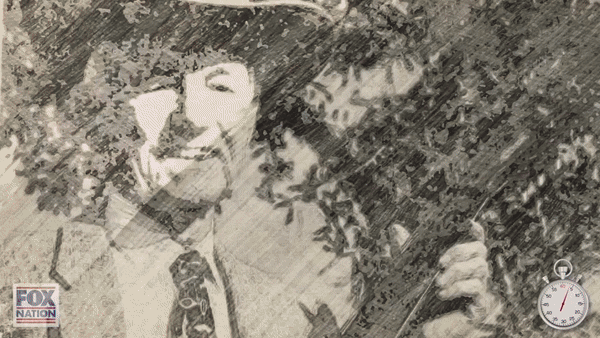
Adolph Rickenbacker (1887-1976), Swiss-born entrepreneur, invented the electric guitar in California alongside partner George Beauchamp in the midst of the Great Depression of the 1930s. (Fox Nation )
The earliest model electric guitar was dubbed the Rickenbacker Frying Pan. It resembled a round cast-iron pan with a long handle. In this case, however, it had a neck of steel guitar strings.
Toth and his wife, Dr. Kathy Schick, also an Indiana University professor emeritus, own one of the earliest-known models of the instrument, a circa-1934 model Frying Pan with the name spelled "Richenbacher."
"The electric guitar was a great social equalizer."
The inventor changed his name later in the 1930s amid growing anti-German sentiment before World War II. His cousin Eddie Rickenbacker, America’s greatest flying ace of World War I, had changed his name years earlier.
The slick entrepreneur looked to capitalize on his war-hero cousin's national popularity, some rock experts have argued, noting that the inventor kept the name Rickenbacher in personal use.
MEET THE AMERICAN BAKER AND BUSINESSWOMAN WHO FOUNDED PEPPERIDGE FARMS
The Rickenbacker Frying Pan quickly proved a commercial success while inspiring waves of imitators, innovations and improvements.
The slick entrepreneur looked to capitalize on his war-hero cousin's national popularity, some rock experts have argued, noting that the inventor kept the name Rickenbacher in personal use.

Ted Nugent, shown performing at a concert at the House of Blues at the Mandalay Bay Resort in Las Vegas, Nevada, in 2007, spoke of the intense power that comes from playing an electric guitar on stage. (Reuters)
The Rickenbacker Frying Pan quickly proved a commercial success while inspiring waves of imitators, innovations and improvements.
Designers such as Les Paul, Leo Fender and Roger Rossmeisl all built upon the technology pioneered by the Rickenbacker Frying Pan — ultimately empowering a raw, energetic and, at first, uniquely American style of music.
"The guitar remains the primary sonic sexual and sensual stimuli for excitable people everywhere," rock star Ted Nugent told Fox News Digital, while describing the intense power that comes from wielding an electric guitar in front of a live audience.
AMERICAN CULTURE QUIZ: TEST YOURSELF ON POP STARS, SPORTS CARS, ROCK GUITARS AND OLYMPIC HIGH BARS
"If ever there was an experience available to mankind that qualifies as ‘out-of-body,' it would be sharing, mining, milking, exploring and collaborating musical guitar-fire with people that love it as much as I do," he also said.
Overcoming tough odds
Adolf Adam Richenbacher was born on April 1, 1887, at 7 Gemsberg St. in Basel, Switzerland. He overcame great personal challenges on his way to reshaping global pop culture.
His father, Adolf Sr., "ran a small business as a cabinetmaker and model-builder," wrote Swiss journalist Baenz Friedli in a biography of the inventor at Rickenbacker.com. The guitar company still bears his Americanized name today.
"While the economic gloom of the 1870s had lifted, the rich had fled the inner city for the suburbs, leaving the narrow, crowded old town to the have-nots."
MEET THE AMERICAN WHO WROTE ‘THE BATTLE HYMN OF THE REPUBLIC’
Amid limited prospects as lower-class citizens of Europe, the family, including Adolf’s oldest sister Emma and newborn brother Robert, left for the United States through the French port of Le Havre in 1891.
Rickenbacker's father lost both legs in a train accident "and began to drink away his pain and grief."
They arrived a week later at Castle Garden, the pre-Ellis Island immigration center at the southern tip of Manhattan, before settling in Columbus, Ohio.
Rickenbacher as a young boy found life no easier in the U.S. His mother Elisabeth died shortly after their arrival, according to the company biography. His dad lost both legs in a train accident "and began to drink away his pain and grief."
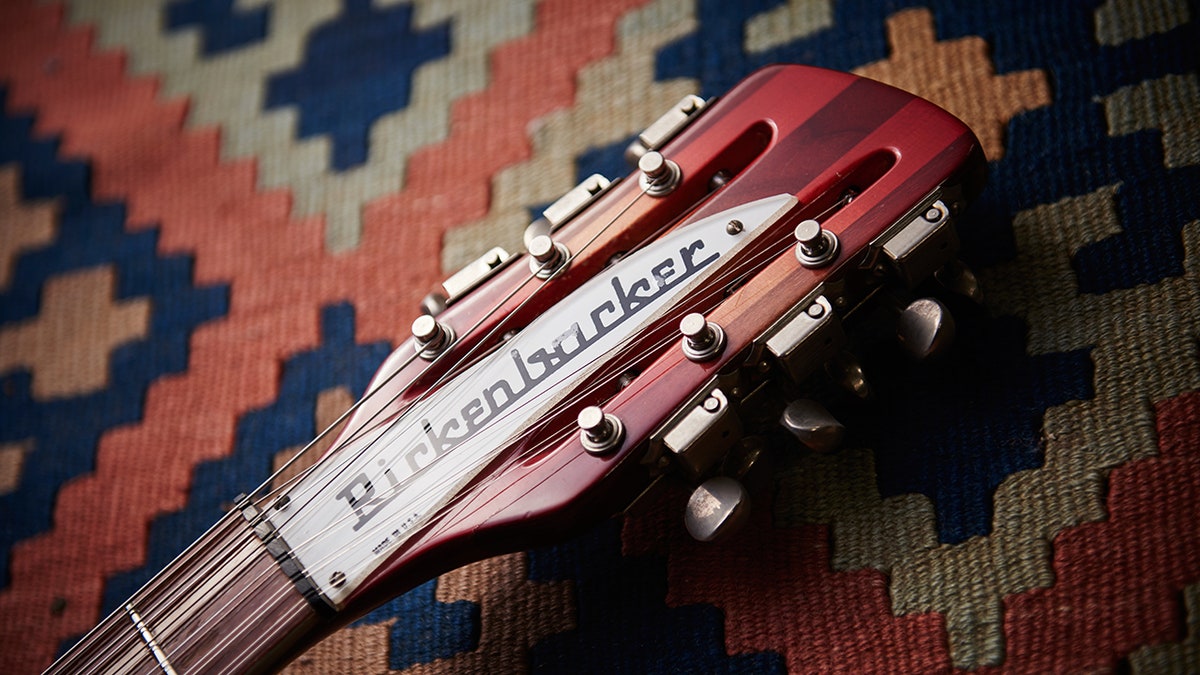
Detail of the headstock on a vintage 1967 Rickenbacker 366-12 Convertible electric guitar with a Fireglo finish, taken on September 29, 2017. (Photo by Joseph Branston/Guitarist Magazine/Future via Getty Images)
Journalist Friedli described a harrowing childhood after the crippled and alcoholic elder Rickenbacher abandoned his own kids.
"Emma rescued her younger brothers from an icy death when she found them, covered with snow, asleep in a doorway," Friedli wrote. "With her rudimentary English, and barely out of childhood herself, she found work as a maid with a wealthy family in the southern end of town, and got permission to lodge Adolf Junior and Robert in her room as well. For seven years Emma raised them there."
The know-how and the funding
Rickenbacher eventually married Charlotte ("Lottie") Kammerer, a first-generation German-American whose family had grown wealthy in the Pennsylvania oil business. He changed his first name to Adolph.
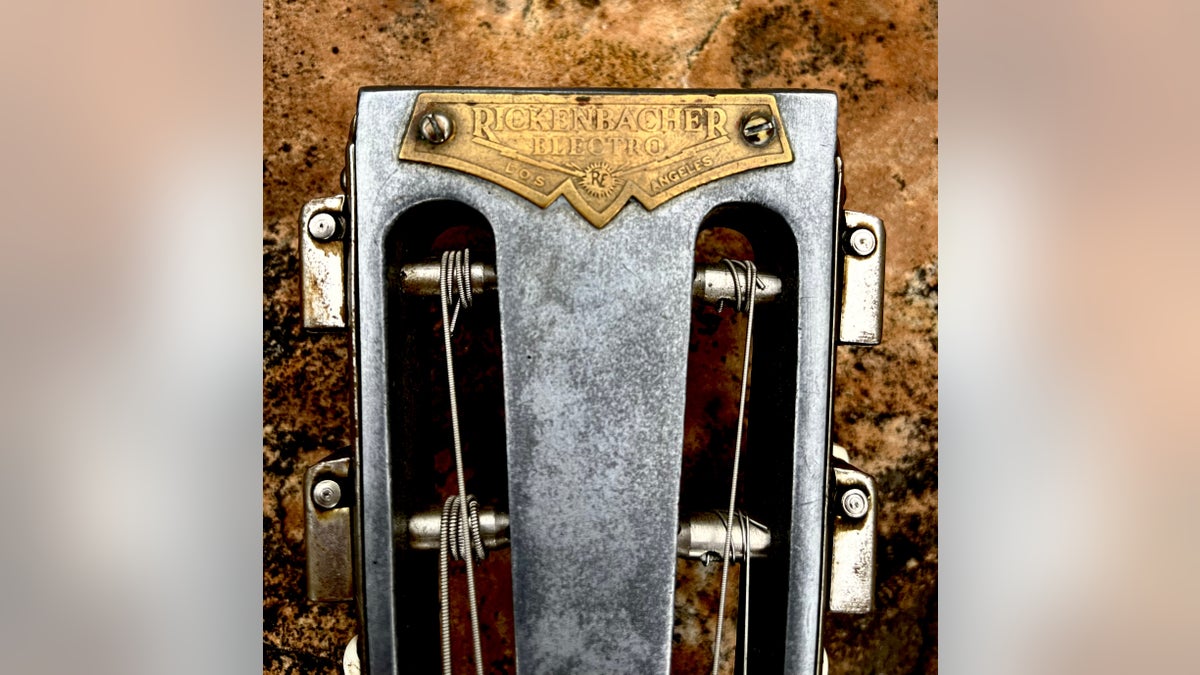
The earliest models of the Rickenbacker Frying Pan, the first electric guitar, were labeled Richenbacher before inventor Adolph Rickenbacker Americanized his name. (Nicholas Toth)
Around 1918, they moved to Los Angeles, where Rickenbacker put his intellect to use, building a manufacturing company that provided metal parts for various industries.
One of its clients was the National String Instrument Co. — whose co-founder George Beauchamp was frustrated in his efforts to electrify guitars.
The two men filed the patent for the "electrical stringed musical instrument" in 1934 and received it in 1937.
Rickenbacker provided the tools, know-how and capital and manufactured the new guitars. Beauchamp was the tinkerer, along with others. Together they created an instrument with electromagnetic pick-up that turned the vibration of strings into electric pulses, which could be dramatically amplified in ways other guitars could not.
The electric guitar was born.
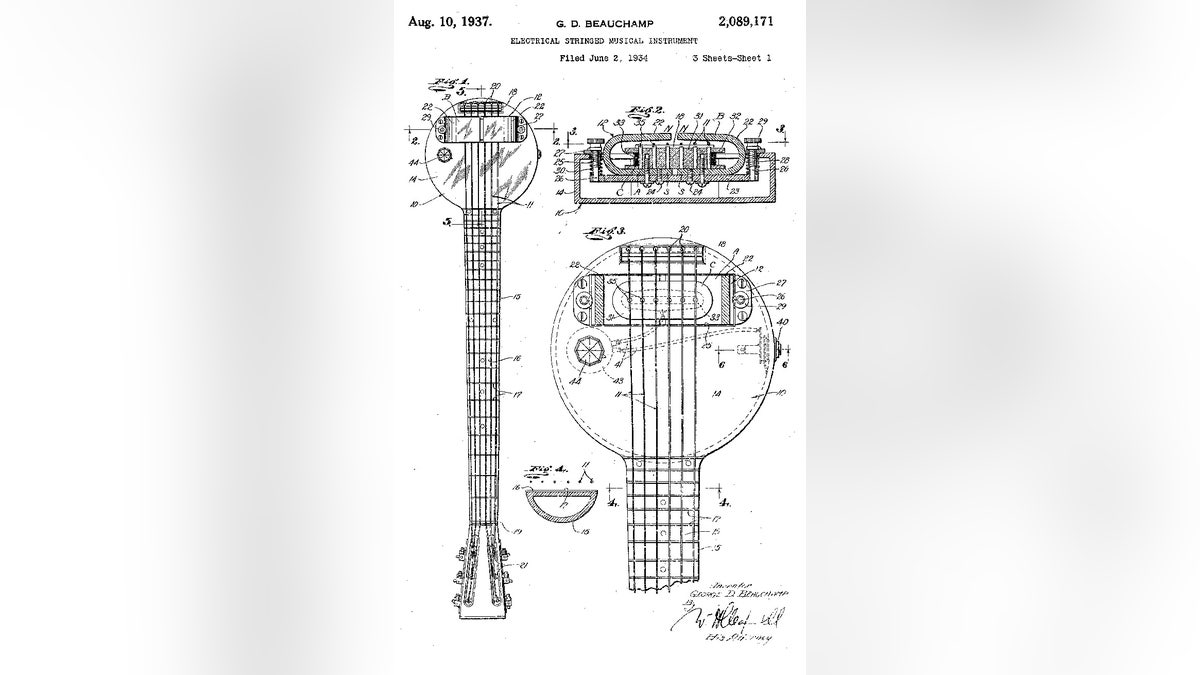
Electrical engineer Adolph Rickenbacker and partner George Beauchamp invented the first mass-market electric guitar in the 1930s. (Public Domain)
The two men filed the patent for the "electrical stringed musical instrument" in 1934 and received it in 1937.
The earliest electric guitars were largely popular among Hawaiian musicians, said Toth.
The nation at the time was in the midst of an obsession with Hawaiian culture — the same craze that fueled, around the same time, the rise of Hawaiian tiki cocktail culture from the likes of Trader Vic or Don the Beachcomber.
American invention embraced by British
American kids from all walks of life soon became aware of the power and potential of the electric guitar that provided the soundtrack to Hawaiian beach vibes.
These were mostly teenagers filled with raw energy and an intense interest in new musical tastes. They'd been weaned on a dynamic American stringed-music culture of blues, jazz, bluegrass and other influences — and they were buoyed by the intense economic success of victorious post-World War II America.
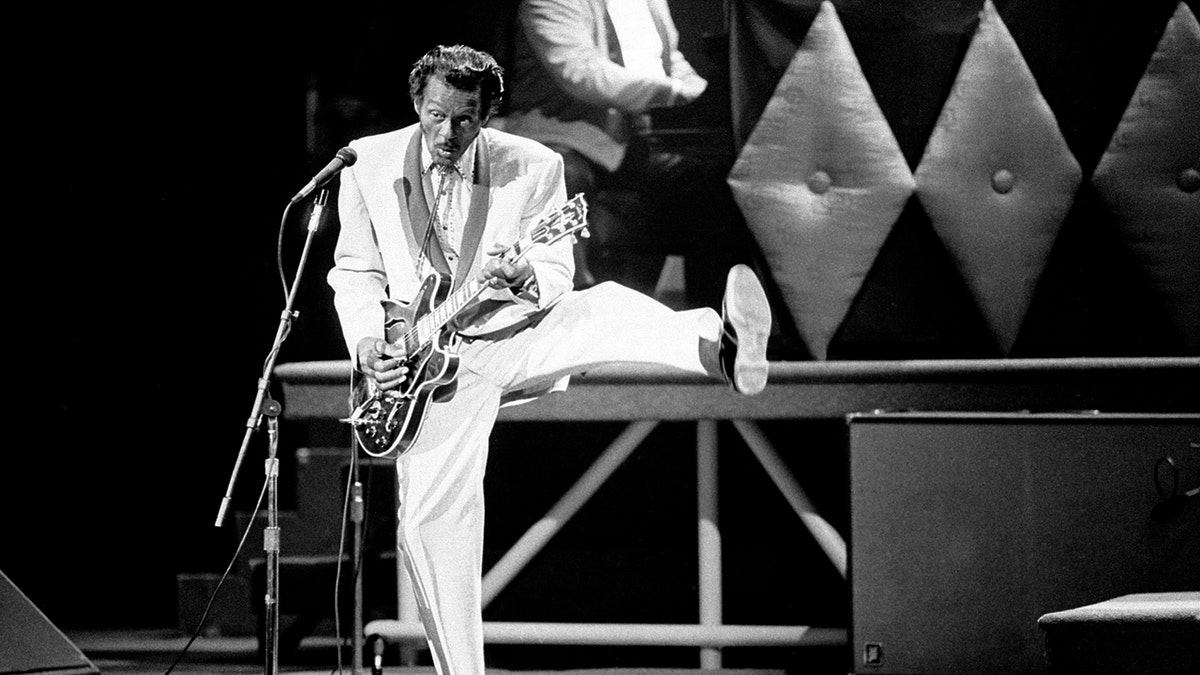
Chuck Berry performs during a concert celebration for his 60th birthday at the Fox Theatre in St. Louis, Mo., on Oct. 17, 1986. The concert was filmed for a motion picture documentary, "Chuck Berry Hail! Hail! Rock 'n' Roll." (AP Photo/James A. Finley)
"Innovative artists in the 1940s and 1950s like Sister Rosetta Tharpe, Les Paul, Muddy Waters and Chuck Berry revolutionized [the electric guitar] and ultimately made it become the primary instrument of rock ‘n’ roll throughout the 1960s and beyond," Andy Leach, senior director of museum and archival collections at the Rock & Roll Hall of Fame, told Fox News Digital.
The electric guitar proved the perfect instrument for an egalitarian society of diverse cultures and influences.
When The Beatles came to America, it was like seeing a new color for the first time.
"I find it very appealing, as an American, that you didn’t need money, prestige or the right background to be a successful musician," said Toth of Indiana University. "The electric guitar was affordable to most people."
AT PAUL MCCARTNEY CONCERT, FANS CELEBRATE SIR PAUL'S 80TH WITH GLEEFUL ‘HAPPY BIRTHDAY'
Americans invented rock ‘n' roll. But the British added a certain flair.
Young English kids such as John Lennon, Paul McCartney, Pete Townshend, Keith Richards, Eric Clapton, Jimmy Page — among a long list of other British musicians — grew mesmerized in the 1950s and 1960s by the pulsating electric guitar sounds emanating across the ocean.
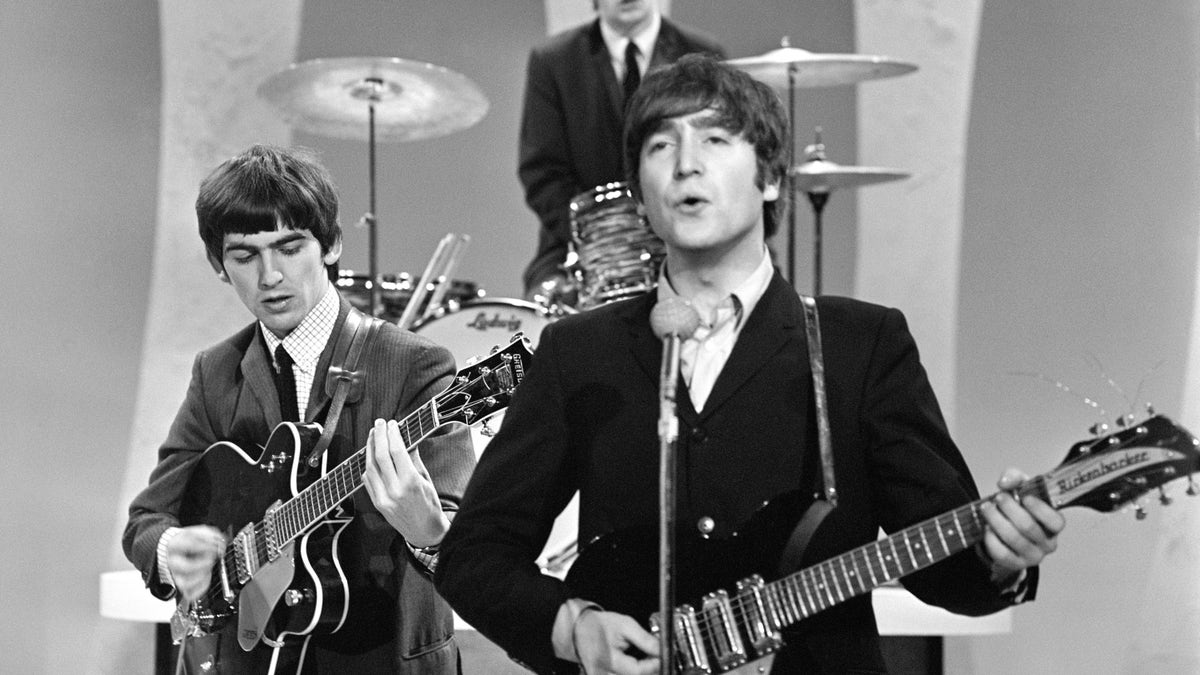
John Lennon played his prized 1958 Rickenbacker 325 when The Beatles appeared on "The Ed Sullivan Show" on Sunday, Feb. 9, 1964, from CBS's Studio 50 in New York City. "Rickenbacker" can be seen across the neck stock of Lennon's guitar. (CBS Photo Archive/Getty Images)
The Beatles counted American rockers Berry, Buddy Holly and Elvis Presley among their greatest influences.
The Fab Four then made American music better and more popular than ever, as the global phenomenon of Beatlemania proved in the 1960s.
8 ROCK STARS WHO ARE STILL ROCKIN' IN THEIR 80S
"When the Beatles came to America, it was like seeing a new color for the first time," a devotee of the band once said.
That brilliant new color was painted with Rickenbacker’s electric guitar.
John Lennon strummed his prized 1958 Rickenbacker 325 when he harmonized "She loves you, yeah, yeah, yeah" for the first time in America on "The Ed Sullivan Show" in early 1964.

The Beatles — from left, Paul McCartney, George Harrison, John Lennon and Ringo Starr — performing on "The Ed Sullivan Show" in February 1964. (Circa Images/GHI/Universal History Archive/Universal Images Group via Getty Images)
The word "Rickenbacker" was emblazoned across the head stock of Lennon's guitar that night.
He was reportedly given a new 1964 Rickenbacker 325 just a few days later — and played the new model when The Beatles returned to "The Ed Sullivan Show" that same February.
Embodiment of the American Dream
After a battle with cancer, Rickenbacker died on March 21, 1976, in Fullerton, Calif. He was 89 years old.
He died with a fabulous gift. He had lived to see his invention, the electric guitar, become a powerful force in pop culture.
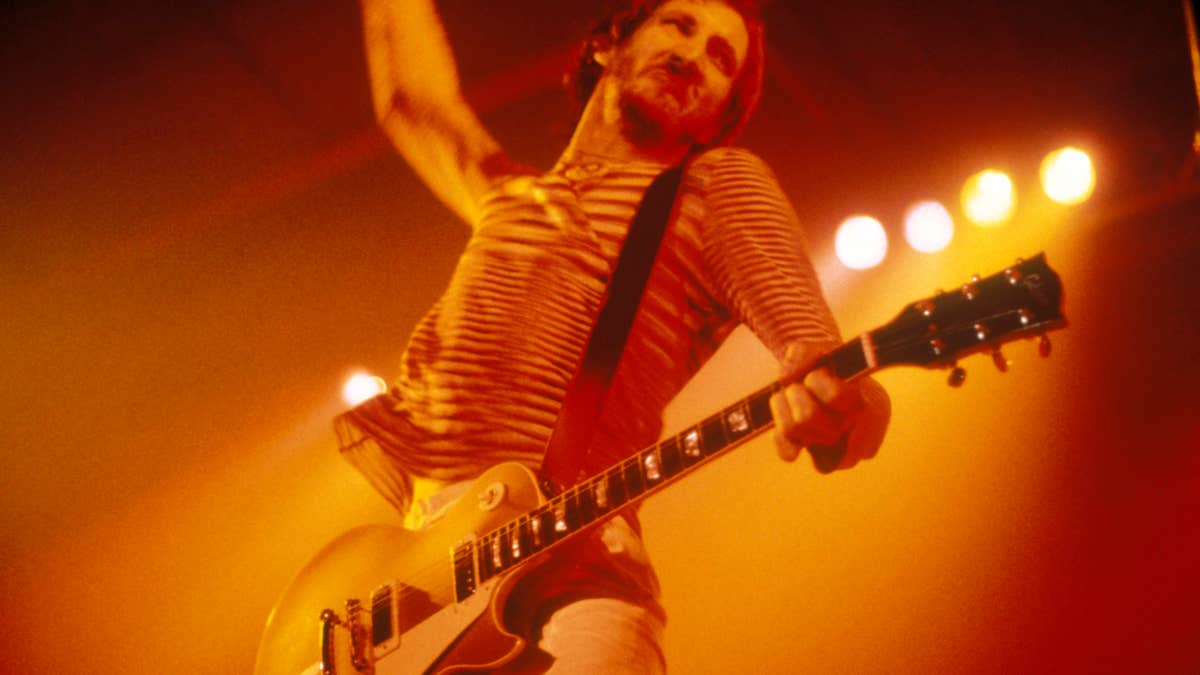
Pete Townshend of The Who performing his guitar windmill on stage. Townshend played a Les Paul here but was inspired to play Rickenbacker guitars after John Lennon popularized the model on American TV. (Graham Wiltshire/Redferns)
The popularity of Rickenbacker guitars, plus Adolph Rickenbacker’s affiliation with rock ‘n' roll lore, skyrocketed in the immediate aftermath of The Beatles' arrival in the U.S.
CLICK HERE TO SIGN UP FOR OUR LIFESTYLE NEWSLETTER
"[Roger] McGuinn bought a Rickenbacker 360/12 after seeing the movie 'A Hard Day's Night' and literally made the bell-like quality of its tone the foundation of the Byrds' early style," according to the Rickenbacker's company history.
He reportedly handed out business cards that read "Adolph Rickenbacher, Father of the Electric Guitar."
"The Who's Peter Townshend, Creedence Clearwater Revival's John Fogerty, Steppenwolf's John Kay and many other well-known 1960s guitarists became faithful Rickenbacker users," the same source said.
For more Lifestyle articles, visit www.foxnews.com/lifestyle
"What had been a six-week waiting period from the factory for some models became a six-month (or longer) waiting period in the mid-1960s."
Rickenbacker flaunted his role in shaping music history. He reportedly handed out business cards that read "Adolph Rickenbacher, Father of the Electric Guitar."
CLICK HERE TO GET THE FOX NEWS APP
"Rickenbacher was the embodiment of the American dream," wrote Friedli, the Swiss biographer.
"He had come [to the U.S.] in 1891 as a poor kid, and he died a wealthy man."
To read more stories in this unique "Meet the American Who…" series from Fox News Digital, click here.























